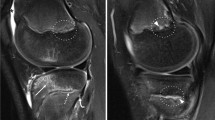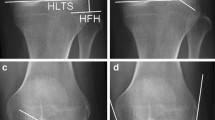Abstract
Physeal changes of any aetiology in children are usually diagnosed once the deformity is clinically evident. Between January 2006 and June 2007, 15 children who suffered from acute osteoarticular infection around the knee joint were studied. They were called up for follow-up six months after the onset of infection. All patients were evaluated by clinical and roentgenographic examination before undergoing magnetic resonance imaging (MRI) study of both knees “with the unaffected knee serving as control”. Abnormal findings in the physis, metaphysis and/or epiphysis on MRI were observed in five children. This group of five children was compared with the other ten children for clinical presentation and course of disease. We believe that MRI is a useful tool in the evaluation of growth plate insult in the early period following acute osteoarticular infection, and we can diagnose and prevent the catastrophic complications of the same.
Résumé
La modification de la physe chez l’enfant, quelle que soit l’étiologie en cause est habituellement diagnostiquée après que la déformation devienne évidente. Entre janvier 2006 et juin 2007, 15 enfants présentant une infection ostéo articulaire aiguë autour du genou ont été étudiés et ont été suivis pendant six mois après le début de l’infection. Les patients ont été évalués de façon clinique et radiographique ainsi qu’avec une étude IRM au niveau des deux genoux, le genou sain servant de contrôle. Des modifications anormales de la physe ou de la métaphyse sur l’IRM ont été observées chez 5 enfants. Ce groupe de 5 enfants est comparé avec l’autre groupe de 10 enfants. Nous espérons que l’IRM sera un examen utile quant à l’évaluation de la lésion précoce de la plaque de croissance avec possibilité d’un diagnostic précoce après une infection ostéo articulaire de façon à prévenir une complication catastrophique.


Similar content being viewed by others
References
Alderson M, Speers D, Emslie K, Nade S (1986) Acute haematogenous osteomyelitis and septic arthritis—a single disease. An hypothesis based upon the presence of transphyseal blood vessels. J Bone Joint Surg Br 68(2):268–274
Malcius D, Trumpulyte G, Barauskas V, Kilda A (2005) Two decades of acute hematogenous osteomyelitis in children: are there any changes? Pediatr Surg Int 21:356–359
Boutin RD, Brossmann J, Sartoris DJ et al (1998) Update on imaging of orthopedic infections. Orthop Clin North Am 29(1):41–66
Jaramillo D, Hoffer FA, Shapiro F, Rand F (1990) MR imaging of fractures of the growth plate. AJR Am J Roentgenol 155:1261–1265
Kharbanda Y, Dhir RS (1991) Natural course of hematogenous pyogenic oOsteomyelitis (a retrospective study of 110 cases). J Postgrad Med 37(2):69–75
Morrey BF, Bianco AJ, Rhodes KH (1975) Septic arthritis in children. Orthop Clin North Am 6:923–928
Ogden JA (1987) The evaluation and treatment of partial physeal arrest. J Bone Joint Surg Am 69:1297–1302
Peltola H, Vahvanen V (1984) A comparative study of osteomyelitis and purulent arthritis with special reference to aetiology and recovery. Infection 12:75–79
Prittchett WJ (1992) Longitudinal growth and growth-plate activity in the lower extremity. Clin Orthop 275:274–277
Rehm PK, Delahay J (1998) Epiphyseal photopenia associated with metaphyseal osteomyelitis and subperiosteal abscess. J Nucl Med 39(6):1084–1086
Rogers LF, Poznanski AK (1994) Imaging of epiphyseal injuries. Radiology 191:297–308
Skinner HB (2003) Current diagnosis and treatment in orthopaedics, 3rd edn. McGraw-Hill, New York, pp 426–448
Smith BG, Rand F, Jaramillo D, Shapiro F (1994) Early MR imaging of lower-extremity fracture separations: a preliminary report. J Pediatr Orthop 14:526–533
Tröbs R, Möritz R, Bühligen U et al (1999) Changing pattern of osteomyelitis in infants and children. Pediatr Surg Int 15:363–372
Wagner DK, Collier BD, Rytel MW (1985) Long-term intravenous antibiotic therapy in chronic osteomyelitis. Arch Intern Med 145:1073–1078
Author information
Authors and Affiliations
Corresponding author
Rights and permissions
About this article
Cite this article
Wardak, E., Gill, S., Wardak, M. et al. Role of MRI in detecting early physeal changes due to acute osteoarticular infection around the knee joint: a pilot study. International Orthopaedics (SICOT) 33, 1707–1711 (2009). https://doi.org/10.1007/s00264-008-0625-9
Received:
Revised:
Accepted:
Published:
Issue Date:
DOI: https://doi.org/10.1007/s00264-008-0625-9




